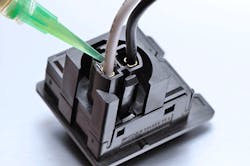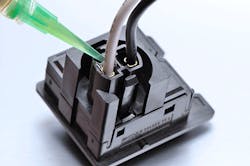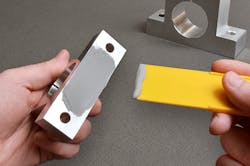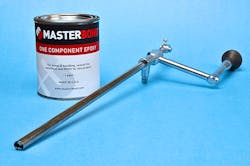One-Part Epoxies are Versatile and Convenient
This file type includes high resolution graphics and schematics when applicable.
One and two-part epoxies are used in countless applications in aerospace, electronics, optical, medical, and a wide range of OEM industries. They are well-suited for bonding, sealing, coating and potting/encapsulation. But although two-part epoxies are more common, one-part epoxies offer distinct advantages in terms of processing.
Process Efficiencies
In a one-part epoxy (assuming it isn’t premixed and frozen or UV curable), the resin and curing agent are both present in the initial mixture. Typically, they polymerize when heat is added. Most one-part epoxies require temperatures of 125° to 150°C for curing, although specialty grades now exist that cure at lower temperatures (80° to 100°C). These are particularly useful for bonding heat-sensitive substrates. One-part epoxies tend to be more exothermic than two-part versions, and in most situations, are limited by curing depths of 0.25 inches or less.
Curing times for one-part epoxies range from a few minutes (so-called snap cures) to several hours. Generally, there can be trade-offs between curing time and performance, specifically in terms of temperature resistance. Epoxies post cured at higher temperatures for longer times are usually stronger with better electrical insulation properties.
One-part epoxies eliminate the need for mixing and, in a sense, have “unlimited working life” at room temperature. That is to say, the open time is comparable to the shelf life, in that the epoxy is applied first and will not fully cure until the appropriate amount of heat is added.
Shelf life and working life are essentially synonymous, so particular attention should be given to storage temperatures. One-part epoxies should be kept at 40°F to 75°F so that the inhibitor does not lose potency, and refrigeration is often even better. Some epoxies degrade when stored at temperatures above 75°F.
Tailoring Characteristics
Most epoxies can be modified in terms of processing or final characteristics by choosing the right resins and hardeners and by adding fillers and diluents. Although two-part epoxies have the broadest array of properties and applicability among adhesives, one-part epoxies can also serve several functions.
There are a number of resins for one-part epoxies, among them high temperature, flexible, and low-ionic variants. The selection of a suitable curing agent, however, is more restricted, unlike two-part versions which have a huge array of options for curing agents.
Curing agents for one part epoxies require heat activation and continued heating. If heat is withdrawn before the material fully cures, the process ceases and the epoxy remains incompletely cured.
Many cured one-part epoxies provide good bond strength to a wide variety of substrates, outstanding mechanical and physical strength, and resistance to high temperatures and chemicals. They can be formulated for almost any viscosity imaginable. However, many users prefer a paste consistency for bonding applications to avoid material flow when heat is applied for curing.
They can also be modified for resistance to chemicals and high temperatures, electrical properties, optical clarity, thermal conductivity, and cure speed. For example, there are epoxy formulations that withstand cryogenic conditions, meet NASA’s low outgassing specifications, or comply with USP Class VI biocompatibility standards.
One-Part Epoxy Applications
One part epoxies are used for bonding, sealing, coating, potting and encapsulation, and impregnation. In electronics and opto-electronics, one-part systems can be used as an underfill in which the epoxy protects and supports delicate flip chips. Important considerations in this application would be good flow and dimensional stability upon curing.
Ultra-low-viscosity one-part epoxies are widely used for various vacuum impregnation applications, ranging from transformer coils to carbon fiber composites. On the other side of the spectrum, thixotropic epoxies are used to attach dies, and as encapsulants and glob tops. Glob tops are applied to circuits, wire bonds, and even delicate electronic components to provide mechanical support and keep out contaminants.
In general, one-part epoxies protect electronic assemblies from environmental factors, as well as more extreme thermal and mechanical stresses. In electro-optical devices, one part epoxies bond LED and display assemblies, as well as bonding, sealing, and coating fiber optics.
One-part epoxies are employed by OEMs as adhesives in applications as diverse as securing motor magnets and joining iron and glass in automobile headlights. Some firms seal and isolate halogen lamps from moisture and other contaminants with these epoxies. They are also applied as protective coatings on armature coils and motors of all sizes.
Some epoxies withstand temperatures as low as 4°K and are suitable for use in cryogenic seals in centrifugal cryogenic pumps, infrared telescopes and detectors, satellite tracking systems, drones, and missile warning systems.
One-part epoxy films are also becoming increasingly popular where uniform bond-line thicknesses are needed. This includes creating a seal on lids, bonding electronic components to heat sinks, and attaching substrates in microelectronic packages. They are even being used somewhat unconventionally in the aerospace industry to bond large substrates on cryogenic tanks.
In all these industries and applications, selecting an appropriate one-part epoxy depends mainly on its cured properties—especially bonding and physical strength, chemical and temperature resistance, electrical and thermal properties, and color. Handling and processing characteristics such as viscosity, the amount of heat they generate while curing, curing conditions, and temperature play roles in the selection process.
Additionally, there are applications where standards such as biocompatibility, UL, mil specifications, and low outgassing influence the selection process.
One-part epoxies offer a range of properties and perform well in a variety of applications. If heat curing is possible and practical, they are an excellent option based on their performance and relatively easy and convenient processing.
This file type includes high resolution graphics and schematics when applicable.
Two-Part Epoxy Basics
This file type includes high resolution graphics and schematics when applicable.
The most basic type of epoxies has two parts: the resin and the curing agent. They make up the majority of industrial-grade epoxies. They form when the resin and curing agent are mixed and polymerize. This process is exothermic, and the heat it generates increases crosslinking between the two components. The reaction’s speed, as well as the final properties of the epoxy, depend on the resin and curing agent. The time it takes to fully cure two-part systems can range from as little as a few hours to two weeks at room temperatures. Often, adding heat accelerates curing, further enhances crosslinking, and improves the final product’s properties.
There are a number of processing related issues that must be considered when using these two-part compounds. First, they all have a specified mix ratio. They may be simple (such as those that are mixed one-to-one by weight or volume) or more arcane (like 17:11). Also, combing the two components requires a level of skill to ensure complete mixing without entrapping air. After the components are thoroughly mixed into an epoxy, application specialists have a limited amount of time to use it. This window of time is called the epoxy’s open time. The specialists need to be aware of the open time. These specialist need to work within the open time. And it’s likely they will make more epoxy than needed, which means some gets wasted.
Unconventional One-Part Epoxies
There are many packing options for one- and two-part epoxies, including B-stages one-part versions and premixed and frozen two-part epoxies. B-staged epoxies consist of resins and hardeners that are partially heat cured, but the cure is interrupted by quenching or cooling while the adhesive is still fusible and soluble. This leaves the epoxy partially cured and “staged” for a full cure, which requires exposure to heat.
These semi-cured epoxies can be packaged in different ways. Some are poured while hot into cans or molds where they solidify and are sold in cans or as “cookies.” Others are formed into solid films or cut to create preforms.
B-staged epoxies are stable when stored at ambient temperatures and can be stored for extended periods if refrigerated. After applied to surface or part, solid B-staged epoxies can be cured to completion in an hour or less by applying heat at 250°F to 350°F. Fully cured B-staged epoxies have characteristics comparable to those of liquid adhesives.
Premixed and two-part epoxies that are thoroughly blended and degassed by the manufacturer can be frozen and packed in dry ice for shipping. When stored at -40°C, they usually have six-month shelf lives and retain their physical and handling properties over that time. Premixed and frozen epoxies require no mixing and cure at room temperature, giving them the performance of two-part epoxies with the ease of use of a single component epoxy.
Robert Michaels, Vice President Technical Sales
Master Bond Inc., Hackensack, N.J.
This file type includes high resolution graphics and schematics when applicable.




